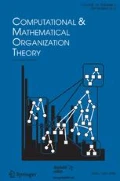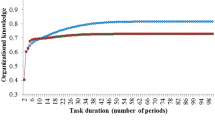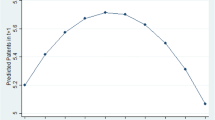Abstract
Extant research has provided ambiguous answers to the question as to what constitutes an ideal balance between exploration and exploitation, in stable and turbulent environments. Much of the literature emphasizes controlling organizational actions by means of predictions based on historical knowledge. In our study, we investigate organizational outcomes when such predictions are not possible and managers intentionally focus their firm on either exploratory or exploitative innovation. Using March’s iconic computational simulation model, we find that multiple exploration–exploitation combinations lead to equivalent, maximum organizational knowledge, establishing a rational basis for managerial intentionality toward exploratory or exploitative innovation. We further find that onset of environmental turbulence impacts an organization focusing on exploratory innovation in a way that is different from the way an organization focusing on exploitative innovation is impacted. The former is enabled to carry out an increasing level of its core activity, exploration. The latter is required to dial down its core activity, exploitation. Our findings suggest a resolution to conflicting prescriptions regarding appropriate response to onset of environmental turbulence endemic in the literature.



Similar content being viewed by others
Notes
Note though, a firm can access heterogeneous external knowledge by a number of alternative mechanisms, for example, strategic alliances, tie-ups with university and research institutions, membership of industry and cross industry bodies and so forth. To stay with March’s terminology we continue to use the term turnover to stand for the entire range of possibilities. We thank two anonymous reviewers for drawing attention to the potential multiple connotations underlying the turnover construct.
We consider learning from the organizational code as local search.
We thank two anonymous reviewers for this suggestion.
At our request, Prof. March made his code available to us. We translated the code from Basic to the scripting language of MATLAB. We found that this translation reproduces March’s results exactly. However, there were minor differences with our version of the code developed with solely the specifications of the (1991) paper, due to some additional assumptions in Prof. March’s coding logic. In the results we display, we have chosen to keep out those additional assumptions. Our principal results, embodied in the three propositions articulated in the previous section hold good regardless of whether we keep or do not keep those assumptions.
We thank an anonymous reviewer for suggesting this experimental variation to us.
We thank an anonymous reviewer for alerting us regarding this implication.
These agents are somewhat ambiguously referred to as ‘investors’. They issue diktats in the name of shareholders, but they themselves are not the shareholders in many cases. Agents who call themselves investors often require that business firms go for profit maximization in every period. If a short term outcome indeed turns out to be favorable, these agents draw large bonuses. If a firm gets destroyed in repeated short termism, it does not directly matter to these agents, since it is their clients’ capital that is on the line (for instance pension funds, insurance funds), not theirs. These agents organize themselves as “too big to fail”. When asset value of funds tank owing to deleterious outcome of short termism, they merely request the government for bailout funds. Frequently, the government obliges, since it is uncomfortable regarding public disclosure of evaporation of pension and insurance fund money.
References
Abernathy WJ (1978) The productivity dilemma: roadblock to innovation in the automobile industry. Johns Hopkins University Press, Baltimore
Andriopoulos C, Lewis MW (2009) Exploitation exploration tensions and organizational ambidexterity: managing paradoxes of innovation. Organ Sci 20(4):696–717
Astley WG, Van de Ven AH (1983) Central perspectives and debates in organization theory. Adm Sci Q 28(2):245–273
Benner MJ, Tushman ML (2002) Process management and technological innovation: a longitudinal study of the photography and paint industries. Adm Sci Q 47(4):676–706
Benner MJ, Tushman ML (2003) Exploitation, exploration, and process management: the productivity dilemma revisited. Acad Manag Rev 28(2):238–256
Birkinshaw J, Gupta K (2013) Clarifying the distinctive contribution of ambidexterity to the field of organization studies. Acad Manag Perspect 27(4):287–298
Boumgarden P, Nickerson J, Zenger TR (2012) Sailing into the wind: exploring the relationships among ambidexterity, vacillation, and organizational performance. Strateg Manag J 33(6):587–610
Burgelman R (1983) Corporate entrepreneurship and strategic management: insights from a process study. Manag Sci 29(12):1349–1364
Cao Q, Gedajlovic E, Zhang H (2009) Unpacking organizational ambidexterity: dimensions, contingencies, and synergistic effects. Organ Sci 20(4):781–796
Chen EL, Katila R (2008) Rival interpretations of balancing exploration and exploitation: simultaneous or sequential? In: Shane S (ed) Handbook of technology and innovation management. Wiley, Chichester, pp 197–214
Child J (1972) Organizational structure, environment and performance: the role of strategic choice. Sociology 6(1):1–22
Cohen MD, Bacdayan P (1994) Organizational routines as stored procedural memory: evidence from a laboratory study. Organ Sci 5(4):554–568
Cohen WM, Levinthal DA (1990) Absorptive capacity: a new perspective on learning and innovation. Adm Sci Q 35(1):128–152
Collins JC (2001) Good to great: Why some companies make the leap… and others don’t. Harper Business
Covey S (1989) The seven habits of highly effective people. Free Press, Boston. ISBN: 0-7432-6951-9
D’Aveni RA, Dagnino GB, Smith KG (2010) The age of temporary advantage. Strateg Manag J 31(13):1371–1385
Denrell J, March JG (2001) Adaptation as information restriction: the hot stove effect. Organ Sci 12(5):523–538
Dizikes P (2010) Explained: Knightian uncertainty. The economic crisis has revived an old philosophical idea about risk and uncertainty. But what is it, exactly? MIT News Office, June 02, 2010. URL: http://web.mit.edu/newsoffice/2010/explained-knightian-0602.html. Accessed 19 Aug 2013
Farjoun M (2010) Beyond dualism: stability and change as duality. Acad Manag Rev 35(2):202–225
Ghemawat P, Costa J (1993) The organizational tension between static and dynamic efficiency. Strateg Manag J 14(8):59–73
Gibson CB, Birkinshaw J (2004) The antecedents, consequences, and mediating role of organizational ambidexterity. Acad Manag J 47(2):209–226
Gupta A, Smith K, Shalley C (2006) The interplay between exploration and exploitation. Acad Manag J 49(4):693–706
He ZL, Wong PK (2004) Exploration versus exploitation: an empirical test of the ambidexterity hypothesis. Organ Sci 15(4):481–494
Hilferding R (1910) Finance capital. London, Boston and Henley: Routledge and Kegan Paul [1981]
Holland J (1975) Adaptation in natural and artificial systems: an introductory analysis with applications to biology, control & artificial intelligence. University of Michigan Press, Ann Arbor
Huber GP (1991) Organizational learning: the contributing processes and the literatures. Organ Sci 2(1):88–115
Hutzschenreuter T, Pedersen T, Volberda HW (2007) Internationalization—the role of managerial intentionality and path dependency: a perspective on international business research. J Int Bus Stud 38(7):1055–1068
Jansen JJP, Van den Bosch FAJ, Volberda HW (2006) Exploratory innovation, exploitative innovation, and performance: effects of organizational antecedents and environmental moderators. Manag Sci 52(11):1661–1674
Katila R, Ahuja G (2002) Something old, something new: a longitudinal study of search behavior and new product introduction. Acad Manag J 45(6):1183–1194
Knight FH (1921) Risk, uncertainty, and profit. Hart, Schaffner & Marx; Houghton Mifflin Company, Boston
Lant T, Mezias S (1992) An organizational learning model of convergence and reorientation. Organ Sci 3(1):47–72
Lavie D, Rosenkopf L (2006) Balancing exploration and exploitation in alliance formation. Acad Manag J 49(4):797–818
Lavie D, Stettner U, Tushman ML (2010) Exploration and exploitation within and across organizations. Acad Manag Ann 4(1):109–155
Levinthal DA, March JG (1993) The myopia of learning. Strateg Manag J 14:95–112
Levitt B, March JG (1988) Organizational learning. Ann Rev Sociol 14:319–340
Lin Z, Yang H, Demirkan I (2007) The performance consequences of ambidexterity in strategic alliance formations: empirical investigation and computational theorizing. Manage Sci 53(10):1645–1658
March JG (1991) Exploration and exploitation in organizational learning. Organ Sci 2(1):71–87
Marx K (1867) [1990] Capital, vol I. Penguin Classics, London
Marx K (1894) [1991] Capital, vol III. Penguin Classics, London
McGrath RG (2001) Exploratory learning, innovative capacity, and managerial oversight. Acad Manag J 44(1):118–131
Michaelides P, Milios J (2005) Did Hilferding influence Schumpeter? Hist Econ Rev 41(Winter):98–125
Miller D, Friesen PH (1980) Momentum and revolution in organizational adaptation. Acad Manag J 23(4):591–614
Miller D, Kets de Vries MFR, Toulouse JM (1982) Top executive locus of control and its relationship to strategy-making, structure and environment. Acad Manag J 25(2):237–253
Mitchell W, Singh K (1993) Death of the lethargic: effects of expansion into new technical subfields on performance in a firm’s base business. Organ Sci 4(2):152–180
Moschieri C, Mair J (2012) Managing divestitures through time—expanding current knowledge. Acad Manag Perspect 26(4):35
Nelson RR, Winter S (1982) An evolutionary theory of economic change. Harvard University Press, Cambridge, MA
Nohria N, Gulati R (1996) Is slack good or bad for innovation? Acad Manag J 39(5):1245–1264
O’Reilly CA, Tushman ML (2008) Ambidexterity as a dynamic capability: resolving the innovator’s dilemma. In: Brief AP, Staw BM (eds) Research in organizational behavior, vol 28., pp 185–206
Peters TJ, Waterman RH (1982) In search of excellence: lessons from America’s best-run companies. Harper & Row, New York
Ployhart RE, Moliterno TP (2011) Emergence of the human capital resource: a multilevel model. Acad Manag Rev 36(1):127–150
Porter ME (1985) Competitive advantage. Free Press, Boston
Posen HE, Levinthal DA (2012) Chasing a moving target: exploitation and exploration in dynamic environments. Manag Sci 58(3):587–601
Prigogine I (1980) From being to becoming. WM Freeman, San Francisco
Raisch S, Birkinshaw J (2008) Organizational ambidexterity: antecedents, outcomes, and moderators. J Manag 34(3):375–409
Rosenkopf L, Almeida P (2003) Overcoming local search through alliances and mobility. Manag Sci 49(6):751–766
Rotter JB (1966) Generalized expectancies for internal versus external control of reinforcement. Psychol Monogr 80:1 Whole No. 609
Schumpeter JA (1942) [1950] Capitalism, socialism and democracy. Harper and Row, New York
Simon HA (1956) Rational choice and the structure of the environment. Psychol Rev 63(2):129–138
Simon HA (1985) Human nature in politics: the dialogue of psychology with political science. Am Polit Sci Rev 79:293–304
Smith WK, Lewis MW (2011) Toward a theory of paradox: a dynamic equilibrium model of organizing. Acad Manag Rev 36(2):381–403
Smith WK, Binns A, Tushman ML (2010) Complex business models: managing strategic paradoxes simultaneously. Long Range Plan 43(2):448–461
Sorensen J, Stuart TE (2000) Aging, obsolescence, and organizational innovation. Adm Sci Q 45(1):81–112
Sull D (1999) The dynamics of standing still: firestone tire & rubber and the radial revolution. Bus Hist Rev 73(Autumn):430–464
Acknowledgments
The authors thank Bill Mckelvey, Phaneesh Puranam, Sendil Ethiraj, William Mitchell, P. Srikant, and the scholars and participants in the Strategic Management Society Research Workshop in IIM Calcutta in 2011 for valuable feedback, comments, clarifications and numerous improvement suggestions at various stages of development of our work. The authors thank the editor and three anonymous reviewers for very good inputs that helped make the paper better. The authors thank Jos Van Der Geest for assistance with MATLAB programming constructs. All errors remain the authors’ responsibility.
Author information
Authors and Affiliations
Corresponding author
Rights and permissions
About this article
Cite this article
Chanda, S.S., Ray, S. Optimal exploration and exploitation: the managerial intentionality perspective. Comput Math Organ Theory 21, 247–273 (2015). https://doi.org/10.1007/s10588-015-9184-y
Published:
Issue Date:
DOI: https://doi.org/10.1007/s10588-015-9184-y




